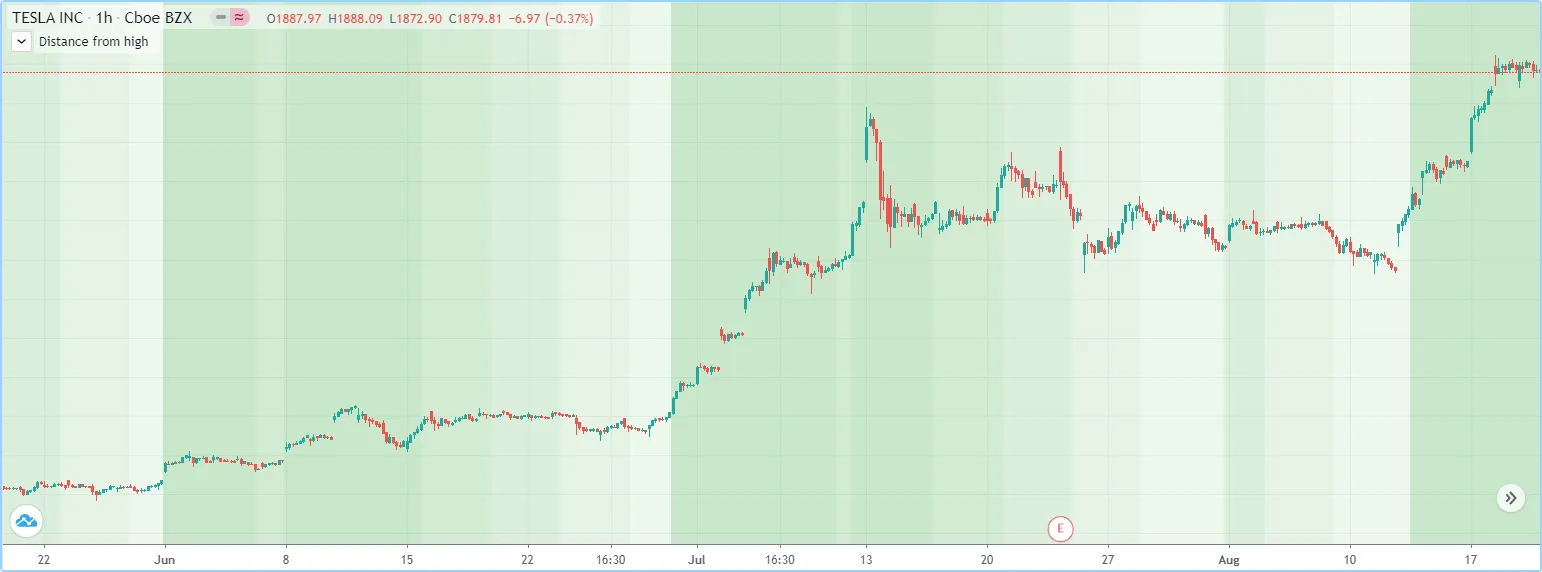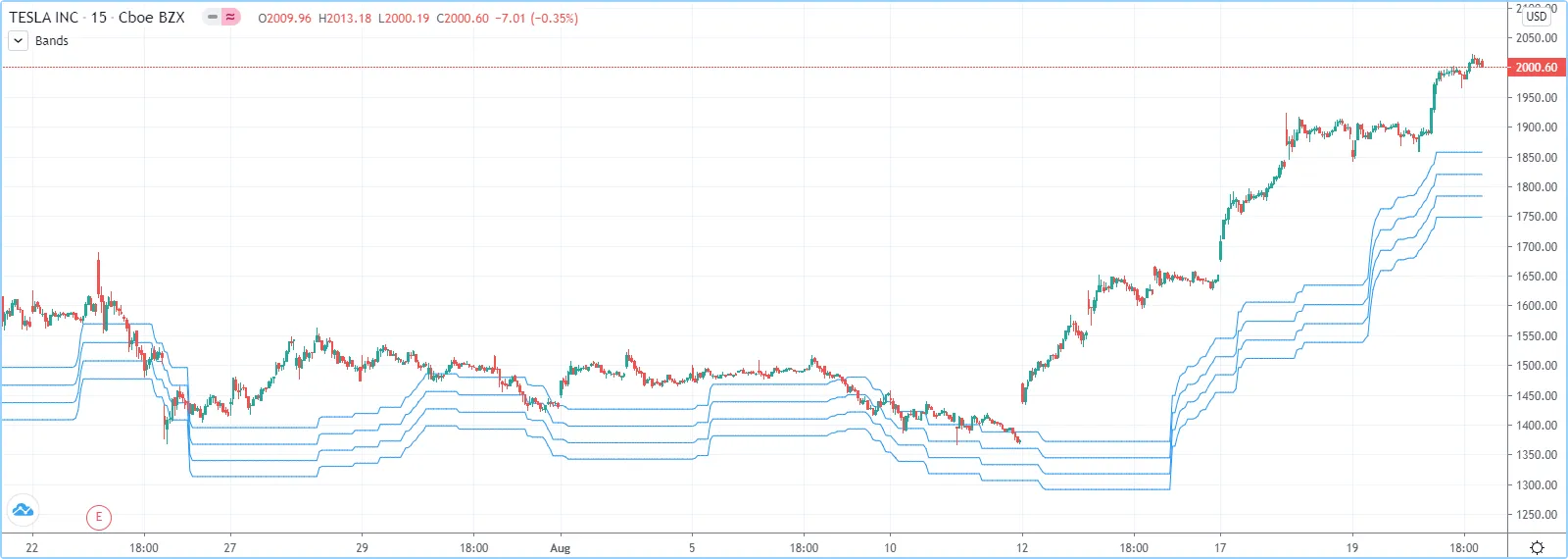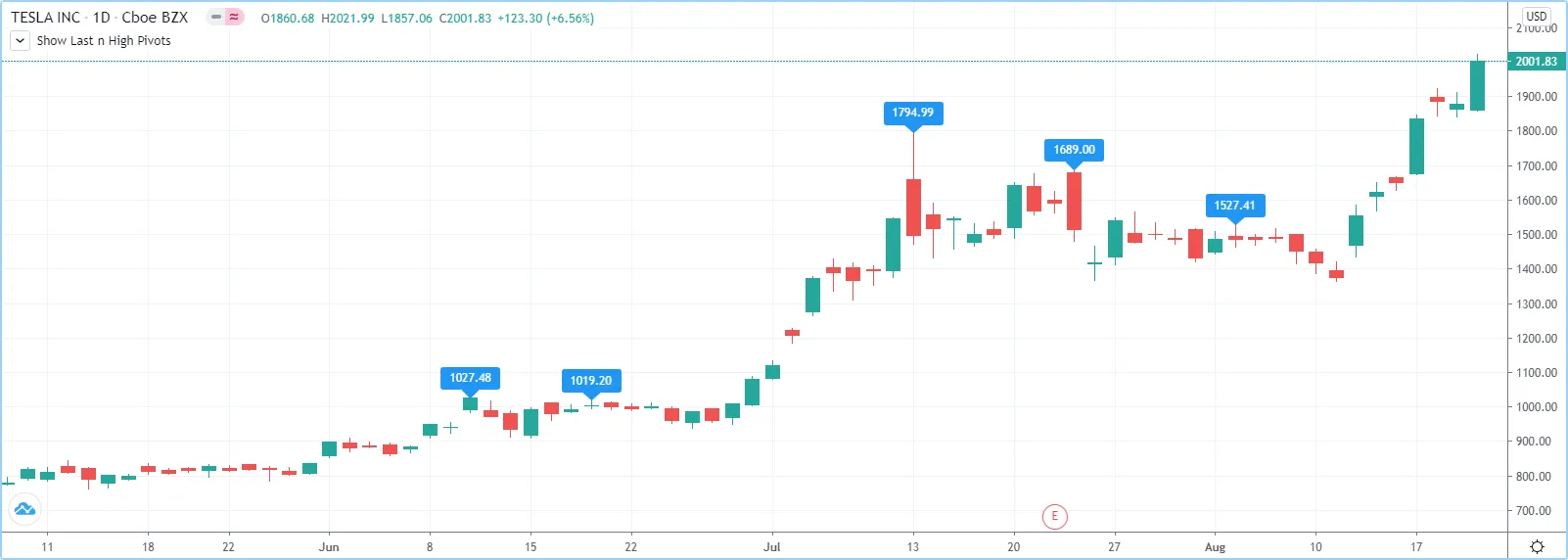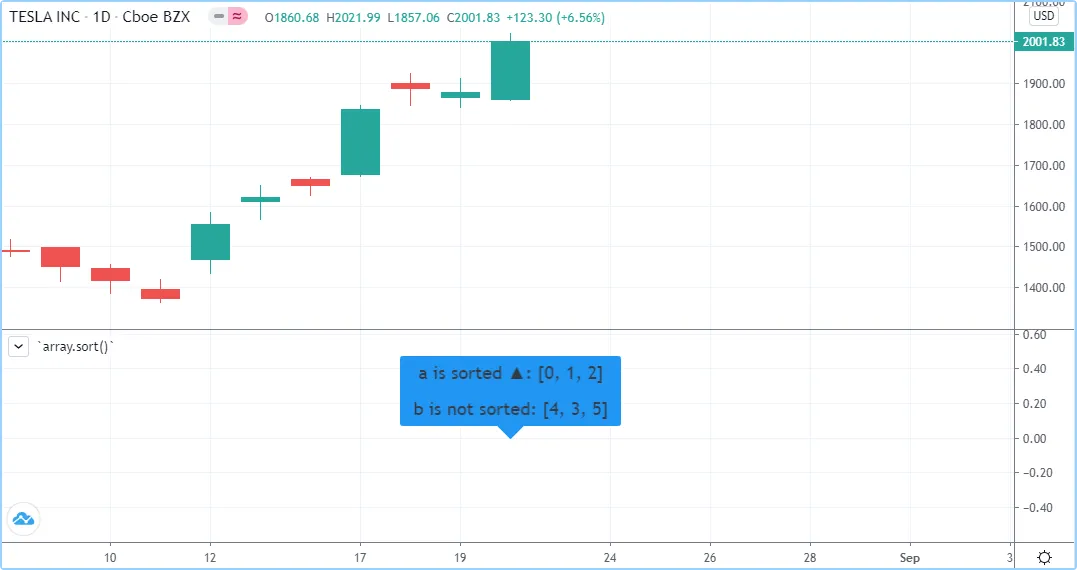数组
介绍
Pine Script™ 数组是可以保存多个值引用的一维集合。可以将它们视为处理需要显式声明一组类似变量的情况的更好方法(例如,,,,... price00)。price01price02
数组中的所有元素必须是相同的内置类型、用户定义类型或枚举类型。
脚本使用类似于线条、标签和其他特殊类型的 ID 的数组 ID 来引用数组。Pine Script™ 不使用索引运算符来引用单个数组元素。相反,包括array.get()和array.set()在内的函数会读取和写入数组元素的值。
脚本使用索引引用数组的元素,索引从 0 开始,一直延伸到数组中元素的数量减一。Pine Script™ 中的数组可以具有动态大小,该大小会随条形图而变化,因为可以在脚本的每次迭代中更改数组中的元素数量。脚本可以包含多个数组实例。数组的大小限制为 100,000 个元素。
声明数组
Pine Script™ 使用以下语法来声明数组:
[var/varip ][array<type>/<type[]> ]<identifier> = <expression>其中<type>是
数组的类型模板<expression>,用于声明它将包含的值的类型,并且返回指定类型的数组或na。
当将变量声明为数组时,我们可以使用
array
关键字,后跟
类型模板。或者,我们也可以使用type名称,后跟
[]修饰符(不要与
[]
历史引用运算符混淆)。
由于 Pine 总是使用类型特定的函数来创建数组,因此
array<type>/type[]声明的部分是多余的,除非声明分配给的数组变量na。即使不需要,明确声明数组类型也有助于向读者清楚地说明意图。
这行代码声明了一个名为的数组变量prices,指向na。在这种情况下,我们必须指定类型来声明变量可以引用包含“浮点”值的数组:
array<float> prices = na
我们也可以把上面的例子写成这种形式:
float[] prices = na
当声明数组并且 不是 时<expression>,na请使用以下函数之一:array.new<type>(size, initial_value)、
array.from()或
array.copy()。对于函数,和参数array.new<type>(size, initial_value)的参数可以是“系列”,以允许动态调整大小和初始化数组元素。以下示例创建一个包含零个“浮点”元素的数组,这一次, array.new<float>()函数调用返回的数组 ID
被分配给:sizeinitial_valueprices
prices = array.new<float>(0)
initial_value函数的参数允许array.new*用户将数组中的所有元素设置为指定的值。如果没有提供参数initial_value,则数组将用na值填充。
此行声明了一个名为数组 ID,prices指向一个包含两个元素的数组,每个元素分配给该条的close值:
prices = array.new<float>(2, close)
要创建数组并使用不同的值初始化其元素,请使用
array.from()。此函数根据函数调用中的参数推断数组的大小及其将保存的元素类型。与array.new*
函数一样,它接受“系列”参数。提供给函数的所有值都必须是同一类型。
例如,所有这三行代码将创建具有相同两个元素的相同“bool”数组:
statesArray = array.from(close > open, high != close)
bool[] statesArray = array.from(close > open, high != close)
array<bool> statesArray = array.from(close > open, high != close)
使用 `var` 和 `varip`关键字
用户可以利用 var和 varip 关键字指示脚本在第一个图表条上第一次迭代时仅声明一次数组变量。使用这些关键字声明的数组变量指向相同的数组实例,直到明确重新分配,从而允许数组及其元素引用在各个条之间持续存在。
当使用这些关键字声明一个数组变量并在每个条形图上将新值推送到引用数组的末尾时,该数组将在每个条形图上增加一,并且在脚本在最后一个条形图上执行时达到大小bar_index + 1
(bar_index
从零开始),如以下代码所示:
//@version=5
indicator("Using `var`")
//@variable An array that expands its size by 1 on each bar.
var a = array.new<float>(0)
array.push(a, close)
if barstate.islast
//@variable A string containing the size of `a` and the current `bar_index` value.
string labelText = "Array size: " + str.tostring(a.size()) + "\nbar_index: " + str.tostring(bar_index)
// Display the `labelText`.
label.new(bar_index, 0, labelText, size = size.large)
相同的代码如果不使用 var 关键字,则会在每个条形上重新声明数组。在这种情况下,执行 array.push ()调用后 , a.size() 调用将返回值 1。
读取和写入数组元素
脚本可以使用array.set(id, index, value)将值写入现有的单个数组元素
,并使用array.get(id, index)读取。使用这些函数时,函数调用中的 必须index始终小于或等于数组的大小(因为数组索引从零开始)。要获取数组的大小,请使用 array.size
(id)
函数。
以下示例使用
set()
方法fillColors使用不同透明度级别的一种基色实例填充数组。然后,它使用
array.get()
根据最后几根柱线中价格最高的柱线的位置从数组中检索一种颜色lookbackInput:

//@version=5
indicator("Distance from high", "", true)
lookbackInput = input.int(100)
FILL_COLOR = color.green
// Declare array and set its values on the first bar only.
var fillColors = array.new<color>(5)
if barstate.isfirst
// Initialize the array elements with progressively lighter shades of the fill color.
fillColors.set(0, color.new(FILL_COLOR, 70))
fillColors.set(1, color.new(FILL_COLOR, 75))
fillColors.set(2, color.new(FILL_COLOR, 80))
fillColors.set(3, color.new(FILL_COLOR, 85))
fillColors.set(4, color.new(FILL_COLOR, 90))
// Find the offset to highest high. Change its sign because the function returns a negative value.
lastHiBar = - ta.highestbars(high, lookbackInput)
// Convert the offset to an array index, capping it to 4 to avoid a runtime error.
// The index used by `array.get()` will be the equivalent of `floor(fillNo)`.
fillNo = math.min(lastHiBar / (lookbackInput / 5), 4)
// Set background to a progressively lighter fill with increasing distance from location of highest high.
bgcolor(array.get(fillColors, fillNo))
// Plot key values to the Data Window for debugging.
plotchar(lastHiBar, "lastHiBar", "", location.top, size = size.tiny)
plotchar(fillNo, "fillNo", "", location.top, size = size.tiny)
初始化数组中元素的另一种方法是创建一个空数组(没有元素的数组),然后使用 array.push() 将新元素附加到数组末尾,每次调用时数组的大小都会增加一。以下代码在功能上与前面脚本中的初始化部分相同:
// Declare array and set its values on the first bar only.
var fillColors = array.new<color>(0)
if barstate.isfirst
// Initialize the array elements with progressively lighter shades of the fill color.
array.push(fillColors, color.new(FILL_COLOR, 70))
array.push(fillColors, color.new(FILL_COLOR, 75))
array.push(fillColors, color.new(FILL_COLOR, 80))
array.push(fillColors, color.new(FILL_COLOR, 85))
array.push(fillColors, color.new(FILL_COLOR, 90))
此代码与上面的代码等效,但它使用
array.unshift()在数组开头
插入新元素fillColors:
// Declare array and set its values on the first bar only.
var fillColors = array.new<color>(0)
if barstate.isfirst
// Initialize the array elements with progressively lighter shades of the fill color.
array.unshift(fillColors, color.new(FILL_COLOR, 90))
array.unshift(fillColors, color.new(FILL_COLOR, 85))
array.unshift(fillColors, color.new(FILL_COLOR, 80))
array.unshift(fillColors, color.new(FILL_COLOR, 75))
array.unshift(fillColors, color.new(FILL_COLOR, 70))
我们还可以使用
array.from()fillColors通过单个函数调用
来创建相同的数组:
//@version=5
indicator("Using `var`")
FILL_COLOR = color.green
var array<color> fillColors = array.from(
color.new(FILL_COLOR, 70),
color.new(FILL_COLOR, 75),
color.new(FILL_COLOR, 80),
color.new(FILL_COLOR, 85),
color.new(FILL_COLOR, 90)
)
// Cycle background through the array's colors.
bgcolor(array.get(fillColors, bar_index % (fillColors.size())))
array.fill(id, value, index_from, index_to)函数
将所有数组元素或
index_fromtoindex_to范围内的元素指向指定的value。如果没有最后两个可选参数,该函数将填充整个数组,因此:
a = array.new<float>(10, close)
和:
a = array.new<float>(10)
a.fill(close)
是等效的,但是:
a = array.new<float>(10)
a.fill(close, 1, 3)
仅用 填充数组的第二和第三个元素(索引 1 和 2)close。请注意
array.fill()的最后一个参数index_to必须比函数将填充的最后一个索引大一。其余元素将保存na值,因为
array.new()
函数调用不包含initial_value参数。
循环遍历数组元素
当循环遍历数组的元素索引并且数组的大小未知时,可以使用 array.size () 函数获取最大索引值。例如:
//@version=5
indicator("Protected `for` loop", overlay = true)
//@variable An array of `close` prices from the 1-minute timeframe.
array<float> a = request.security_lower_tf(syminfo.tickerid, "1", close)
//@variable A string representation of the elements in `a`.
string labelText = ""
for i = 0 to (array.size(a) == 0 ? na : array.size(a) - 1)
labelText += str.tostring(array.get(a, i)) + "\n"
label.new(bar_index, high, text = labelText)
注意:
- 我们使用
request.security_lower_tf()函数,它返回时间范围
内的收盘价
数组
1 minute。 - 如果在小于的图表时间范围内使用此代码示例,将引发错误
1 minute。 to如果表达式为 na ,则for 循环不会执行。请注意,该to值仅在输入时被评估一次。
循环遍历数组的另一种方法是使用
for…in
循环。这种方法是标准 for 循环的变体,可以迭代数组中的值引用和索引。下面是如何使用循环编写上述代码示例的示例
for...in:
//@version=5
indicator("`for...in` loop", overlay = true)
//@variable An array of `close` prices from the 1-minute timeframe.
array<float> a = request.security_lower_tf(syminfo.tickerid, "1", close)
//@variable A string representation of the elements in `a`.
string labelText = ""
for price in a
labelText += str.tostring(price) + "\n"
label.new(bar_index, high, text = labelText)
注意:
- for…in
循环可以返回包含每个索引和相应元素的元组。例如,
for [i, price] in a返回中每个元素的i索引和price值a。
也可以使用 while 循环语句 :
//@version=5
indicator("`while` loop", overlay = true)
array<float> a = request.security_lower_tf(syminfo.tickerid, "1", close)
string labelText = ""
int i = 0
while i < array.size(a)
labelText += str.tostring(array.get(a, i)) + "\n"
i += 1
label.new(bar_index, high, text = labelText)
范围
用户可以在脚本的全局范围内以及 函数、 方法和 条件结构的本地范围内声明数组。与其他一些内置类型(即 基本类型)不同,脚本可以在本地范围内修改全局分配的数组,从而允许用户实现脚本中的任何函数都可以直接与之交互的全局变量。我们在此处使用此功能来逐步计算较低或较高的价格水平:

//@version=5
indicator("Bands", "", true)
//@variable The distance ratio between plotted price levels.
factorInput = 1 + (input.float(-2., "Step %") / 100)
//@variable A single-value array holding the lowest `ohlc4` value within a 50 bar window from 10 bars back.
level = array.new<float>(1, ta.lowest(ohlc4, 50)[10])
nextLevel(val) =>
newLevel = level.get(0) * val
// Write new level to the global `level` array so we can use it as the base in the next function call.
level.set(0, newLevel)
newLevel
plot(nextLevel(1))
plot(nextLevel(factorInput))
plot(nextLevel(factorInput))
plot(nextLevel(factorInput))
历史参考
Pine Script™ 的历史引用运算符[ ]可以访问数组变量的历史记录,允许脚本与之前分配给变量的过去的数组实例进行交互。
为了说明这一点,让我们创建一个简单的示例,展示如何close以两种等效方式获取前一个条形图的值。此脚本使用[ ]a运算符获取前一个条形图上
分配的数组实例,然后使用get()
方法检索第一个元素的值 ( previousClose1)。对于previousClose2,我们直接对变量使用历史引用运算符
close来检索值。从图中可以看出,previousClose1和previousClose2都返回相同的值:

//@version=5
indicator("History referencing")
//@variable A single-value array declared on each bar.
a = array.new<float>(1)
// Set the value of the only element in `a` to `close`.
array.set(a, 0, close)
//@variable The array instance assigned to `a` on the previous bar.
previous = a[1]
previousClose1 = na(previous) ? na : previous.get(0)
previousClose2 = close[1]
plot(previousClose1, "previousClose1", color.gray, 6)
plot(previousClose2, "previousClose2", color.white, 2)
插入和删除数组元素
插入
以下三个函数可以将新元素插入到数组中。
array.unshift() 在数组的开头(索引 0)插入一个新元素,并将任何现有元素的索引值增加一。
array.insert()
在指定位置插入一个新元素index,并将现有元素的索引或之后的索引增加index一。

//@version=5
indicator("`array.insert()`")
a = array.new<float>(5, 0)
for i = 0 to 4
array.set(a, i, i + 1)
if barstate.islast
label.new(bar_index, 0, "BEFORE\na: " + str.tostring(a), size = size.large)
array.insert(a, 2, 999)
label.new(bar_index, 0, "AFTER\na: " + str.tostring(a), style = label.style_label_up, size = size.large)
array.push() 在数组末尾添加一个新元素。
移除
这四个函数从数组中删除元素。前三个函数还返回被删除元素的值。
array.remove()
删除指定位置的元素index并返回该元素的值。
array.shift() 从数组中删除第一个元素并返回其值。
array.pop() 删除数组的最后一个元素并返回其值。
array.clear() 会从数组中删除所有元素。请注意,清除数组不会删除其元素引用的任何对象。请参阅下面的示例,了解其工作原理:
//@version=5
indicator("`array.clear()` example", overlay = true)
// Create a label array and add a label to the array on each new bar.
var a = array.new<label>()
label lbl = label.new(bar_index, high, "Text", color = color.red)
array.push(a, lbl)
var table t = table.new(position.top_right, 1, 1)
// Clear the array on the last bar. This doesn't remove the labels from the chart.
if barstate.islast
array.clear(a)
table.cell(t, 0, 0, "Array elements count: " + str.tostring(array.size(a)), bgcolor = color.yellow)
使用数组作为堆栈
堆栈是 LIFO(后进先出)结构。它们的行为有点像一堆垂直的书,每次只能从顶部添加或移除一本书。Pine Script™ 数组可以用作堆栈,在这种情况下,我们使用 array.push () 和 array.pop() 函数在数组末尾添加和移除元素。
array.push(prices, close)将会在数组末尾添加一个新元素
prices,从而将数组的大小增加一。
array.pop(prices)将从数组中删除末尾元素prices,返回其值并将数组的大小减少一。
看看这里如何使用这些函数来追踪反弹中的连续低点:

//@version=5
indicator("Lows from new highs", "", true)
var lows = array.new<float>(0)
flushLows = false
// Remove last element from the stack when `_cond` is true.
array_pop(id, cond) => cond and array.size(id) > 0 ? array.pop(id) : float(na)
if ta.rising(high, 1)
// Rising highs; push a new low on the stack.
lows.push(low)
// Force the return type of this `if` block to be the same as that of the next block.
bool(na)
else if lows.size() >= 4 or low < array.min(lows)
// We have at least 4 lows or price has breached the lowest low;
// sort lows and set flag indicating we will plot and flush the levels.
array.sort(lows, order.ascending)
flushLows := true
// If needed, plot and flush lows.
lowLevel = array_pop(lows, flushLows)
plot(lowLevel, "Low 1", low > lowLevel ? color.silver : color.purple, 2, plot.style_linebr)
lowLevel := array_pop(lows, flushLows)
plot(lowLevel, "Low 2", low > lowLevel ? color.silver : color.purple, 3, plot.style_linebr)
lowLevel := array_pop(lows, flushLows)
plot(lowLevel, "Low 3", low > lowLevel ? color.silver : color.purple, 4, plot.style_linebr)
lowLevel := array_pop(lows, flushLows)
plot(lowLevel, "Low 4", low > lowLevel ? color.silver : color.purple, 5, plot.style_linebr)
if flushLows
// Clear remaining levels after the last 4 have been plotted.
lows.clear()
使用数组作为队列
队列是先进先出 (FIFO) 结构。它们的行为有点像到达红灯的汽车。新车排在队尾,最先离开的汽车将是第一个到达红灯的汽车。
在下面的代码示例中,我们让用户通过脚本的输入决定他们想要在图表上显示多少个标签。我们使用该数量来确定随后创建的标签数组的大小,并将数组的元素初始化为na。
当检测到新的枢轴时,我们会为其创建一个标签,并将标签的 ID 保存在变量中pLabel。然后,我们使用
array.push()
将新标签的 ID 附加到数组末尾,将该标签的 ID 排队,使数组大小比图表上要保留的最大标签数量大一。
最后,我们使用array.shift()删除数组的第一个元素,
并删除该数组元素值引用的标签,从而取消最旧的标签的排队。由于我们现在已经从队列中取消了一个元素,因此数组
pivotCountInput再次包含元素。请注意,在数据集的第一个条形图上,我们将删除na标签 ID,直到创建了最大数量的标签,但这不会导致运行时错误。让我们看看我们的代码:

//@version=5
MAX_LABELS = 100
indicator("Show Last n High Pivots", "", true, max_labels_count = MAX_LABELS)
pivotCountInput = input.int(5, "How many pivots to show", minval = 0, maxval = MAX_LABELS)
pivotLegsInput = input.int(3, "Pivot legs", minval = 1, maxval = 5)
// Create an array containing the user-selected max count of label IDs.
var labelIds = array.new<label>(pivotCountInput)
pHi = ta.pivothigh(pivotLegsInput, pivotLegsInput)
if not na(pHi)
// New pivot found; plot its label `i_pivotLegs` bars back.
pLabel = label.new(bar_index[pivotLegsInput], pHi, str.tostring(pHi, format.mintick), textcolor = color.white)
// Queue the new label's ID by appending it to the end of the array.
array.push(labelIds, pLabel)
// De-queue the oldest label ID from the queue and delete the corresponding label.
label.delete(array.shift(labelIds))
数组计算
虽然序列变量可以看作是沿时间回溯的水平值集,但 Pine Script™ 的一维数组可以看作是驻留在每个条形上的垂直结构。由于数组的元素集不是 时间序列,因此不允许对其使用 Pine Script™ 的常用数学函数。必须使用专用函数来对数组的所有值进行操作。可用的函数有: array.abs()、 array.avg()、 array.covariance()、 array.min()、 array.max()、 array.median()、 array.mode()、 array.percentile_linear_interpolation()、 array.percentile_nearest_rank()、 array.percentrank()、 array.range()、 array.standardize()、 array.stdev()、 array.sum()、 array.variance()。
na请注意,与 Pine Script™ 中通常的数学函数相反,当数组上使用的函数计算的某些值有值时,它们不会返回na。此规则有几个例外:
- 当数组所有元素都有
na值或者数组不包含任何元素时,na将返回。array.standardize()但是,将返回一个空数组。 array.mode()na当未找到模式时将返回。
操作数组
级联
可以使用array.concat()合并(或连接)两个数组 。连接数组时,第二个数组将附加到第一个数组的末尾,因此第一个数组被修改,而第二个数组保持不变。该函数返回第一个数组的数组 ID:

//@version=5
indicator("`array.concat()`")
a = array.new<float>(0)
b = array.new<float>(0)
array.push(a, 0)
array.push(a, 1)
array.push(b, 2)
array.push(b, 3)
if barstate.islast
label.new(bar_index, 0, "BEFORE\na: " + str.tostring(a) + "\nb: " + str.tostring(b), size = size.large)
c = array.concat(a, b)
array.push(c, 4)
label.new(bar_index, 0, "AFTER\na: " + str.tostring(a) + "\nb: " + str.tostring(b) + "\nc: " + str.tostring(c), style = label.style_label_up, size = size.large)
复印
您可以使用array.copy()复制数组
。这里我们将数组复制a到名为的新数组_b:

//@version=5
indicator("`array.copy()`")
a = array.new<float>(0)
array.push(a, 0)
array.push(a, 1)
if barstate.islast
b = array.copy(a)
array.push(b, 2)
label.new(bar_index, 0, "a: " + str.tostring(a) + "\nb: " + str.tostring(b), size = size.large)
请注意,在上例中,简单地使用_b = a不会复制数组,而只会复制其 ID。从那时起,两个变量都会指向同一个数组,因此使用任何一个都会影响同一个数组。
加入
使用 array.join() 将数组中的所有元素连接成一个字符串,并用指定的分隔符分隔这些元素:
//@version=5
indicator("")
v1 = array.new<string>(10, "test")
v2 = array.new<string>(10, "test")
array.push(v2, "test1")
v3 = array.new_float(5, 5)
v4 = array.new_int(5, 5)
l1 = label.new(bar_index, close, array.join(v1))
l2 = label.new(bar_index, close, array.join(v2, ","))
l3 = label.new(bar_index, close, array.join(v3, ","))
l4 = label.new(bar_index, close, array.join(v4, ","))
排序
包含“int”或“float”元素的数组可以使用array.sort()按升序或降序排序
。该order参数是可选的,默认为
order.ascending。与所有array.*()函数参数一样,它被限定为“series”,因此可以在运行时确定,就像这里所做的那样。请注意,在示例中,哪个数组被排序也是在运行时确定的:

//@version=5
indicator("`array.sort()`")
a = array.new<float>(0)
b = array.new<float>(0)
array.push(a, 2)
array.push(a, 0)
array.push(a, 1)
array.push(b, 4)
array.push(b, 3)
array.push(b, 5)
if barstate.islast
barUp = close > open
array.sort(barUp ? a : b, barUp ? order.ascending : order.descending)
label.new(bar_index, 0,
"a " + (barUp ? "is sorted ▲: " : "is not sorted: ") + str.tostring(a) + "\n\n" +
"b " + (barUp ? "is not sorted: " : "is sorted ▼: ") + str.tostring(b), size = size.large)
对数组进行排序的另一个有用选项是使用
array.sort_indices()
函数,该函数引用原始数组并返回包含原始数组索引的数组。请注意,此函数不会修改原始数组。该order参数是可选的,默认为
order.ascending。
逆转
使用 array.reverse() 来反转数组:
//@version=5
indicator("`array.reverse()`")
a = array.new<float>(0)
array.push(a, 0)
array.push(a, 1)
array.push(a, 2)
if barstate.islast
array.reverse(a)
label.new(bar_index, 0, "a: " + str.tostring(a))
切片
使用
array.slice() 对index_from数组进行切片会创建父数组子集的浅表副本。您可以使用和参数
确定要切片的子集的大小index_to
。index_to参数必须比要切片的子集的末尾大一。
切片创建的浅拷贝就像父数组内容的窗口。切片使用的索引定义窗口在父数组上的位置和大小。如果像下面的示例一样,从数组的前三个元素(索引 0 到 2)创建切片,那么无论对父数组做了什么更改,只要它至少包含三个元素,浅拷贝就会始终包含父数组的前三个元素。
此外,一旦创建了浅拷贝,对拷贝的操作就会镜像到父数组上。如下例所示,在浅拷贝的末尾添加一个元素,会将窗口加宽一个元素,并将该元素插入到父数组的索引 3 处。在此示例中,要将数组的子集从索引 0 切分到索引 2
a,我们必须使用_sliceOfA = array.slice(a, 0, 3):

//@version=5
indicator("`array.slice()`")
a = array.new<float>(0)
array.push(a, 0)
array.push(a, 1)
array.push(a, 2)
array.push(a, 3)
if barstate.islast
// Create a shadow of elements at index 1 and 2 from array `a`.
sliceOfA = array.slice(a, 0, 3)
label.new(bar_index, 0, "BEFORE\na: " + str.tostring(a) + "\nsliceOfA: " + str.tostring(sliceOfA))
// Remove first element of parent array `a`.
array.remove(a, 0)
// Add a new element at the end of the shallow copy, thus also affecting the original array `a`.
array.push(sliceOfA, 4)
label.new(bar_index, 0, "AFTER\na: " + str.tostring(a) + "\nsliceOfA: " + str.tostring(sliceOfA), style = label.style_label_up)
搜索数组
我们可以使用array.includes()函数测试某个值是否是数组的一部分 ,如果找到该元素,则返回 true。我们可以使用 array.indexof () 函数找到数组中某个值的第一个出现位置。第一个出现的位置是索引最低的位置。我们还可以使用 array.lastindexof()找到某个值的最后一个出现位置:
//@version=5
indicator("Searching in arrays")
valueInput = input.int(1)
a = array.new<float>(0)
array.push(a, 0)
array.push(a, 1)
array.push(a, 2)
array.push(a, 1)
if barstate.islast
valueFound = array.includes(a, valueInput)
firstIndexFound = array.indexof(a, valueInput)
lastIndexFound = array.lastindexof(a, valueInput)
label.new(bar_index, 0, "a: " + str.tostring(a) +
"\nFirst " + str.tostring(valueInput) + (firstIndexFound != -1 ? " value was found at index: " + str.tostring(firstIndexFound) : " value was not found.") +
"\nLast " + str.tostring(valueInput) + (lastIndexFound != -1 ? " value was found at index: " + str.tostring(lastIndexFound) : " value was not found."))
我们还可以对数组执行二分搜索,但请注意,对数组执行二分搜索意味着首先需要按升序对数组进行排序。 如果找到了值,array.binary_search() 函数将返回值的索引,如果未找到,则返回 -1。如果我们想始终从数组中返回现有索引,即使未找到我们选择的值,那么我们可以使用其他可用的二分搜索函数之一。array.binary_search_leftmost () 函数,如果找到了值,则返回索引,否则返回左侧找到值的第一个索引。array.binary_search_rightmost () 函数几乎相同,如果找到了值,则返回索引,否则返回右侧找到值的第一个索引。
错误处理
array.*()Pine 脚本中的
调用语法格式错误会导致在保存脚本时在 Pine Editor 的控制台(窗口底部)中出现
常见的编译器错误消息。如果对函数调用的确切语法有疑问,请参阅 Pine Script™ v5 参考手册。
使用数组的脚本也可能会抛出运行时错误,这些错误在图表上以感叹号的形式出现在指标名称旁边。我们将在本节中讨论这些运行时错误。
索引 xx 超出范围。数组大小为yy
这很可能是你遇到的最常见错误。当你引用不存在的数组索引时,就会发生这种情况。“xx”值将是你尝试使用的错误索引的值,“yy”将是数组的大小。回想一下,数组索引从零开始——而不是一——并以数组的大小减一结束。因此,大小为 3 的数组的最后一个有效索引为2。
为了避免此错误,您必须在代码逻辑中采取措施,防止使用超出数组索引边界的索引。此代码将生成错误,因为我们在循环中使用的最后一个索引超出了数组的有效索引范围:
//@version=5
indicator("Out of bounds index")
a = array.new<float>(3)
for i = 1 to 3
array.set(a, i, i)
plot(array.pop(a))
正确的for说法是:
for i = 0 to 2
要循环遍历未知大小的数组中的所有数组元素,请使用:
//@version=5
indicator("Protected `for` loop")
sizeInput = input.int(0, "Array size", minval = 0, maxval = 100000)
a = array.new<float>(sizeInput)
for i = 0 to (array.size(a) == 0 ? na : array.size(a) - 1)
array.set(a, i, i)
plot(array.pop(a))
当您使用脚本的“设置/输入”选项卡中的字段动态调整数组大小时
,请使用input.int()minval和参数
保护该值的边界
maxval:
//@version=5
indicator("Protected array size")
sizeInput = input.int(10, "Array size", minval = 1, maxval = 100000)
a = array.new<float>(sizeInput)
for i = 0 to sizeInput - 1
array.set(a, i, i)
plot(array.size(a))
请参阅 本页的循环部分以了解更多信息。
当数组 ID 为“na”时无法调用数组方法
当数组 ID 初始化为 时na,不允许对其进行操作,因为不存在数组。此时存在的只是一个包含值的数组变量,na而不是指向现有数组的有效数组 ID。请注意,创建的数组中没有元素(如使用 时),a = array.new_int(0)但仍然具有有效 ID。此代码将引发我们正在讨论的错误:
//@version=5
indicator("Out of bounds index")
array<int> a = na
array.push(a, 111)
label.new(bar_index, 0, "a: " + str.tostring(a))
为了避免这种情况,请使用以下命令创建一个大小为零的数组:
array<int> a = array.new_int(0)
或者:
a = array.new_int(0)
数组太大。最大大小为100000
如果您的代码尝试声明一个大小大于 100,000 的数组,则会出现此错误。如果在动态向数组添加元素时,新元素导致数组大小超过最大值,也会出现此错误。
无法创建具有负数大小的数组
目前我们还没发现负数大小数组有任何用途,但是如果你发现了,我们可能会允许它们:)
如果数组为空,则不能使用 shift() 。
如果调用array.shift() 来删除空数组的第一个元素,就会发生此错误 。
如果数组为空,则不能使用 pop() 。
如果调用 array.pop() 来删除空数组的最后一个元素,就会发生此错误 。
索引“from”应小于索引“to”
当在array.slice()等函数中使用两个索引时 ,第一个索引必须始终小于第二个索引。
切片超出了父数组的边界
每当父数组的大小被修改,使得切片创建的浅拷贝指向父数组的边界之外时,就会出现此消息。此代码将重现它,因为在从索引 3 到 4(我们的五元素父数组的最后两个元素)创建切片后,我们删除父数组的第一个元素,使其大小为 4,最后一个索引为 3。从那一刻起,仍然指向父数组索引 3 到 4 处的“窗口”的浅拷贝指向父数组的边界之外:
//@version=5
indicator("Slice out of bounds")
a = array.new<float>(5, 0)
b = array.slice(a, 3, 5)
array.remove(a, 0)
c = array.indexof(b, 2)
plot(c)